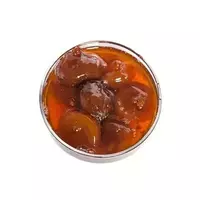Fig jam

No wonder fig jam has been prepared since ancient times. This excellent fruit in terms of its taste, in terms of iron content, is superior to an apple, while it contains slightly less potassium than nuts. In addition, fresh figs are rich in calcium, phosphorus, copper, iodine and magnesium. Its regular use contributes to the rapid restoration of strength and is distinguished by a healing effect for the cardiovascular system.
In addition, the useful properties of figs in any form (including in the form of fig jam) are that the substances in its composition prevent the formation of blood clots in the human body, therefore, this product is recommended for venous diseases and anemia. Its distinctive properties are known for reducing blood sugar levels along with improving the functioning of the digestive system.
It is worth noting that the only drawback of this fruit is that it does not last long when fresh. So, after even a short stay in the sun, the fruits begin to wander, fully justifying their second name - wine berry. However, figs can be used to make a huge number of excellent treats - jam, jelly, compote, marmalade, wine, and undoubtedly fig jam.
A fairly simple fig jam recipe allows you to enjoy this sweet meal all year long. To do this, fresh figs are washed and ponytails are separated from the fruits. Punctures are made over the entire surface of the fig by toothpick - so they will remain intact during the preparation process. In a saucepan, the figs are blanched twice for five minutes and then left to drain.
In a medium-sized saucepan, water and granulated sugar combine, which form a saturated sugar syrup within a few minutes of boiling. Blanched figs are laid in it, which is cooked in syrup for about half an hour. As a result of this method, fig jam is obtained, in which the fruits practically do not lose shape, remaining intact.
Interestingly, it is also possible to make fig jam from dried fruits, which are always on sale, unlike fresh fruits. In taste and appearance, the treat is practically no different from jam based on raw fruits. To do this, dried fruits boil a little in water until they are no longer wrinkled. After that, the water is drained into other dishes, and the figs themselves are washed with cold water. The decoction is strained to transparency, combined with sugar in certain proportions and boiled to the consistency of the syrup. Further, fig jam is prepared in a similar way to a dish of fresh fig fruits.
236 kCal fig jam
Energy value of fig jam (Ratio of proteins, fats, carbohydrates - ju):
Proteins: 0 g (~ 0 kCal)
Fats: 0 g (~ 0 kCal)
Carbohydrates: 62g (~ 248kCal)
Energy ratio (bj | y): 0% | 0% | 105%
 Español
Español Français
Français Português
Português Русский
Русский 简体中文
简体中文 繁體中文
繁體中文 日本語
日本語 한국어
한국어 العربية
العربية Türkçe
Türkçe Қазақ
Қазақ Deutsch
Deutsch Italiano
Italiano Українська
Українська
